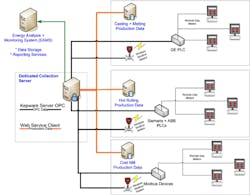Foiling Excessive Energy Consumption
Unless you have been in a cave over the last few months, you are well aware that energy consumption and costs have taken over the nation’s conscience. To remain competitive, the shrinking industrial base must be wise in its use of resources such as gas and electricity. Within the metals industries, and in particular aluminum manufacturing, large amounts of gas and electricity are required to generate the end product. To produce one pound of aluminum from alumina requires about 6.2 kilowatt hours of electricity.
Once the raw material has been created, aluminum is cast into furnaces or smelters, requiring about 1,100 BTUs per lb to liquefy. To examine further, one Standard Cubic Foot (SCF) of natural gas can generate a range of 800 to 1,100 BTUs. It takes roughly 2,100 BTUs per lb to melt aluminum to allow for casting. Given a large ingot of 30,000 lbs, the number of BTUs needed equates to some very large natural gas bills.
In order to ensure natural gas usage remains constant in relation to the manufactured weight, Deadline Solutions, Inc., has come up with a solution to provide reporting and trending of natural gas usage within the aluminum industry. In order to accomplish this goal two key variables need to be harvested: gas usage in SCF and pounds produced over time. The consumption and processing of these variables would become the Energy Analysis + Monitoring System (EAMS).
Who is using the gas?
Within most aluminum facilities, there’s a variety of existing natural gas meters in place to help trend the gas usage. One of the first obstacles to overcome is the wide disparity of control systems within the factory floor that contains the flow data. Some aluminum manufacturing facilities will have a casting group, cold rolling and hot rolling facilities, which may use control systems from different manufacturers ranging from GE to Siemens.
To solve this problem, Deadline Solutions selected Kepware Technologies, in Portland, Maine, to provide a landing zone of all natural gas readings into one process. Kepware manufactures OPC (OPen Connectivity) software that can speak with the various programmable logic controllers (PLCs) found within the site. Deadline Solutions was required to solve this problem by connecting to Allen-Bradley brand PLCs, various Modbus devices, Yokogawa and GE 9070 PLCs. Kepware has an out-of-the-box solution for each of these devices, providing a single source concentrator of OPC data. With all of the OPC data contained in one location, trending and management of these variant natural gas flow meters becomes routine.
In order to obtain a higher degree of accuracy, secondary natural gas flow meters where installed to fill the gaps of existing meters. Use of wireless technologies was employed to save on material and labor costs. The secondary network consisted of wireless RF modems providing coverage over the entire site. A wireless flow meter configuration could be placed where required within the facility, with no concern for the location of dependant resources such as wired LAN connectivity. Base stations were designed at key locations to accept the wireless data and ground it to the automation LAN. Once the data was available on the LAN, the Kepware Modbus driver was used to collect and store the flow data to EAMS.
With flow data trended over time, the consumption of gas is computed to the hour or day as the base unit. Gaps in data would cause under-reporting of gas consumption with EAMS. The reliability and stability Kepware OPC Servers to collect the flow data is fundamental for the EAMS system to be successful.
For more information about OPC solutions from Kepware Technologies, visit www.kepware.com.
For the full story please go here:
http://www.kepware.com/Solution_Chronicles/Energy_Analysis_Monitoring_Systems.html

